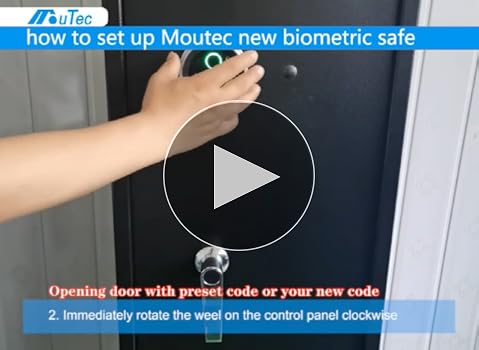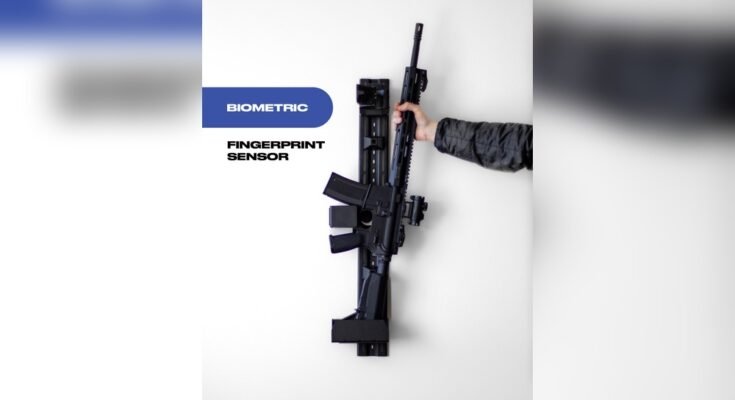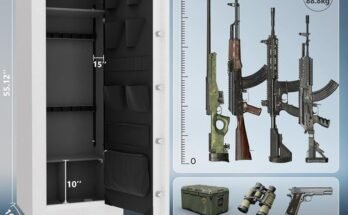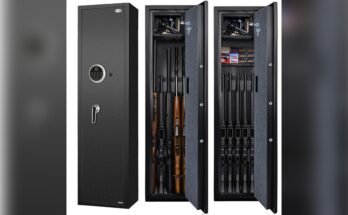Are you looking for a way to keep your firearms secure but still easily accessible? Installing a biometric rifle safe might be the perfect solution for you.
With quick fingerprint access and strong protection, it offers peace of mind like no other safe. But how do you install one correctly to ensure it works flawlessly when you need it most? In this guide, you’ll discover simple, step-by-step instructions that anyone can follow.
Keep reading to make sure your rifle safe is set up right, so your guns stay safe and ready at all times.
Choosing The Right Location
Choosing the right location for your biometric rifle safe is very important. This step helps protect your firearms and ensures easy access. A good spot keeps the safe hidden from strangers and safe from damage. Think carefully about where to place your safe before installation. The right location supports security and convenience.
Consider Accessibility And Security
Pick a place easy to reach in emergencies. The safe should be near where you keep your rifles. Avoid locations visible to visitors or intruders. Choose a spot that balances quick access and privacy. Think about who might need to use the safe. Keep it out of reach of children and unauthorized people.
Check Wall And Floor Strength
Make sure the wall or floor can hold the safe’s weight. Biometric safes are heavy, especially when full. Test the surface by pressing or tapping lightly. Avoid drywall or weak wood panels. Concrete or solid wood walls work best. Secure the safe firmly to prevent movement or theft.
Avoid Moisture And Temperature Extremes
Keep the safe away from damp places like basements or bathrooms. Moisture can damage firearms and electronic parts of the safe. Avoid spots near heaters, windows, or air conditioners. Extreme heat or cold can affect the safe’s function. A dry, stable environment helps the safe last longer.

Gathering Necessary Tools
Gathering the right tools is the first step to install a biometric rifle safe. Having everything ready makes the installation smooth and fast. It also helps avoid interruptions during the process. Knowing what tools and safety gear you need keeps the work safe and efficient.
List Of Essential Tools
Start with a power drill. It helps make holes for screws quickly. Use drill bits that fit the screws of your safe. A screwdriver set is necessary for tightening screws by hand.
Get a tape measure to mark exact spots. A pencil or marker helps draw guide lines. A level ensures your safe is straight and secure. A stud finder locates strong wall points to anchor the safe. Lastly, have a wrench or pliers ready for bolts or nuts.
Safety Equipment To Use
Wear safety glasses to protect your eyes from dust and debris. Gloves prevent cuts and improve grip on tools and materials. Use ear protection if you use loud power tools. Keep a dust mask handy to avoid breathing dust from drilling. Dress in sturdy clothes that cover arms and legs. Clear the workspace to avoid trips and falls.
Preparing The Safe
Preparing your biometric rifle safe is the first step to ensure smooth installation and use. This stage involves unpacking, checking the parts, installing the battery, and setting the initial code. Each task is simple but important to secure your rifle safely and make the biometric system work properly.
Take your time to follow these steps carefully. Proper preparation helps avoid issues later and keeps your safe functioning well.
Unpacking And Inspecting
Open the box carefully and remove all items. Check the safe, battery pack, mounting hardware, and manual. Look for any damage or missing parts. A quick inspection saves time and trouble later. Make sure the safe door opens and closes smoothly.
Battery Installation
Find the battery compartment, usually inside the safe door. Insert the batteries following the correct polarity. Use fresh, high-quality batteries for reliable performance. Close the compartment securely to avoid power loss. The biometric scanner needs power to read fingerprints accurately.
Setting The Initial Code
Turn on the safe’s keypad or biometric system. Follow the manual to set your first access code. Choose a simple code you can remember but hard for others to guess. This code acts as a backup if the fingerprint scanner fails. Test the code to ensure it works before continuing.
Mounting The Safe
Mounting the biometric rifle safe securely is crucial for safety and protection. A well-mounted safe prevents theft and keeps your firearms stable. Follow each step carefully to ensure a strong hold.
Marking Drill Points
First, place the safe where you want it mounted. Use a pencil to mark drill points through the mounting holes. Double-check the marks for accuracy. Ensure the marks align with a solid surface like wood or concrete.
Drilling Holes Safely
Wear safety goggles and gloves before drilling. Use a drill bit suitable for the surface type. Drill slowly and steadily at the marked points. Avoid forcing the drill to prevent damage or injury.
Securing The Safe To The Surface
Use strong bolts or screws included with the safe. Insert them through the mounting holes into the drilled holes. Tighten securely with a wrench or screwdriver. Check the safe for any movement to confirm it is firm.
Programming The Biometric System
Programming the biometric system is the key step in using your rifle safe. It allows you to set up who can open the safe by using fingerprints. This process ensures only authorized users can access your firearms.
Most biometric safes have easy-to-follow steps to register fingerprints and set backup codes. Taking time to program the system correctly improves security and convenience.
Registering Fingerprints
Start by opening the safe and locating the biometric sensor. Press the program button to enter fingerprint registration mode. Place your finger on the sensor firmly and hold it still.
The system will scan your fingerprint several times. It may ask you to lift and place your finger multiple times for accuracy. Register at least two fingerprints from different fingers.
Save each fingerprint by following the on-screen or manual instructions. This helps the safe recognize your prints quickly. Avoid dirty or wet fingers during registration.
Testing Access And Backup Codes
After registering fingerprints, test the access by locking the safe and trying to open it with your finger. The safe should open smoothly if the print matches. Test all registered fingerprints for reliability.
Set backup codes for extra security. These codes work if the fingerprint sensor fails or if your fingers are injured. Choose simple but hard-to-guess codes.
Practice using the backup codes to ensure you remember them. Store the codes safely and do not share them with others.

Final Safety Checks
After installing your biometric rifle safe, final safety checks are crucial. These checks confirm the safe works correctly and keeps your firearms secure. Skipping this step can cause frustration or unsafe situations.
Take time to carefully test every feature. The goal is smooth operation and quick access when needed. Follow this guide to finish your installation confidently.
Verifying Lock Functionality
Test the biometric scanner several times. Place your finger on the sensor until the safe opens. Try different registered fingerprints to confirm all are recognized.
Check the locking mechanism by closing the door and letting it lock automatically. Ensure the safe stays locked and does not open without a fingerprint or code.
Ensuring Emergency Access
Locate the backup key or override code. Use it to open the safe in case the biometric system fails. This step guarantees access during power loss or system errors.
Practice accessing the safe with the backup method. Keep the key or code in a secure, known place outside the safe.
Routine Maintenance Tips
Keep the fingerprint scanner clean. Wipe it gently with a soft cloth to avoid damage. Dirt or moisture can cause errors in reading fingerprints.
Check battery levels regularly. Replace batteries before they run out to prevent lockouts. Use recommended batteries for best performance.
Test the safe monthly to ensure all functions work smoothly. Early detection of issues avoids bigger problems later.

Frequently Asked Questions
How Do I Install A Biometric Rifle Safe Securely?
To install a biometric rifle safe securely, choose a solid surface like concrete or wood. Use the provided mounting hardware and follow the manufacturer’s instructions carefully. Ensure the safe is anchored tightly to prevent theft or movement, enhancing your firearm’s security.
What Tools Are Needed To Install A Biometric Rifle Safe?
You typically need a drill, screwdriver, measuring tape, and mounting bolts. Some safes may also require a wrench or level. Always check the installation guide for specific tool recommendations to ensure proper and safe mounting of your biometric rifle safe.
How To Program Fingerprints On A Biometric Rifle Safe?
Open the safe and access the control panel. Follow the manufacturer’s instructions to register fingerprints. Usually, you press a button, scan your finger multiple times, and save the data. This ensures only authorized users can open the safe quickly and securely.
Can I Install A Biometric Rifle Safe On Drywall?
Installing directly on drywall is not recommended due to weak support. Instead, mount the safe into studs or use a mounting board attached to studs. This provides the necessary strength to hold the safe and keep your firearms secure and protected.
Conclusion
Installing a biometric rifle safe keeps your firearms secure and easy to access. Follow each step carefully to ensure proper setup. Test the fingerprint scanner before locking your safe. Place the safe in a stable, hidden spot for safety. Regularly update the fingerprint settings for better security.
This simple process protects your guns from unauthorized use. Stay safe and responsible with your firearm storage.



